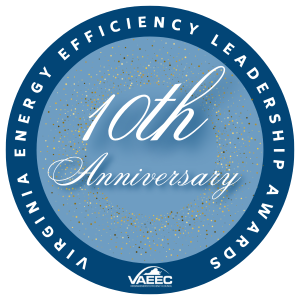2025 Virginia Energy Efficiency Leadership Awards
 This is the tenth year in which the VAEEC has honored individuals, organizations, and companies for their energy efficiency achievements. Launched in 2016 at the recommendation of Governor McAuliffe’s Executive Committee on Energy Efficiency, the awards showcase how energy efficiency champions across the Commonwealth are helping businesses, governments, homeowners, and schools save money on energy bills, reduce energy consumption, and stimulate job growth and our economy.
This is the tenth year in which the VAEEC has honored individuals, organizations, and companies for their energy efficiency achievements. Launched in 2016 at the recommendation of Governor McAuliffe’s Executive Committee on Energy Efficiency, the awards showcase how energy efficiency champions across the Commonwealth are helping businesses, governments, homeowners, and schools save money on energy bills, reduce energy consumption, and stimulate job growth and our economy.
As in previous years, this was a competitive process, highlighting the great work being accomplished in the Commonwealth. I would like to thank each and every group that submitted an application this year. It is your stories and achievements that help us talk with legislators and other decision-makers about the importance of the energy efficiency industry in Virginia.
All 2025 Energizing Efficiency Campaign participants can be viewed on the VAEEC campaign page.
2025 Award Winners
ACADEMIC CATEGORY
- Fume Hood Optimization Project
- Awarded to Virgina Tech Department of Facilities and CMTA
GOVERNMENT CATEGORY
- Fairfax County Spring Hill Recreation Center
- Awarded to Fairfax County and CMTA
Summaries
ACADEMIC CATEGORY
11 Laboratory Fume Hood Optimizations Project
Awarded to Virginia Tech Department of Facilities and CMTA
Virginia Tech conducted a campus-wide study to assess the safety, performance, and energy efficiency of laboratory fume hoods across multiple research buildings. The study identified 11 high-priority buildings for optimization and partnered with CMTA to perform detailed testing, recalibration, and full retro-commissioning of lab and mechanical systems.
Key actions included using the Siemens Building Automation System for diagnostics, performing hydronic and airflow testing, recalibrating fume hood monitors, and holding weekly collaborative meetings to promptly resolve identified issues. Each building received a detailed issue list and a systems manual executive summary following ASHRAE Guideline 1.4’2019.
The project is expected to achieve over $250,000 in energy savings with a 4-year simple payback, while improving safety, thermal comfort, and operational reliability. Benefits include verified fume hood performance, resolved system issues, optimized ventilation, and actionable plans for future improvements. Overall, the initiative supports Virginia Tech’s Climate Action Commitment by reducing energy use and providing a replicable model for other campus and peer institution laboratories.
GOVERNMENT CATEGORY
Fairfax County Spring Hill Recreation Center
Awarded to Fairfax County and CMTA
Spring Hill Recreation Center (SHRC) in Fairfax County, Virginia, underwent a major energy efficiency retrofit through a partnership between OEEC, FCPA, and CMTA to support the County’s Operational Energy Strategy, which targets a 25% energy reduction by 2030 and carbon neutrality by 2040.
SHRC was prioritized due to high energy use, aging mechanical systems, and the potential impact of upgrades. The project replaced or upgraded end-of-life equipment, including the chiller, boilers, cooling towers, air handlers, and pool dehumidification units. The team implemented a suite of Energy Conservation Measures (ECMs), including LED lighting retrofits, BAS upgrades, a geothermal HVAC system, and pool waste heat recovery. Funding was achieved through County ARPA funds and the IRA Tax Credit.
Post-upgrade, SHRC is projected to reduce annual energy use by 37-46% (FY25 actual: 6,348,974 kBTU saved), cut carbon emissions by 530 MT CO-e, and improve indoor environmental quality, including temperature consistency, air quality, and lighting. A rooftop solar array generates 366,030 kWh, further lowering energy consumption and emissions. The building’s Energy Use Intensity (EUI) dropped from 215.50 to 114.41, demonstrating a significant step toward Fairfax County’s climate and energy goals.
The retrofit benefits thousands of residents and provides a replicable model for future county energy projects.
